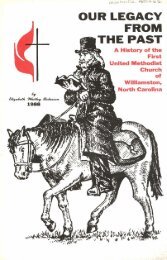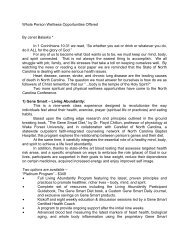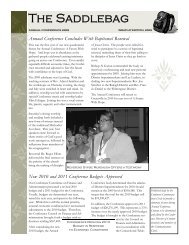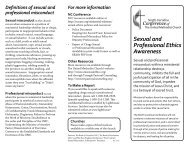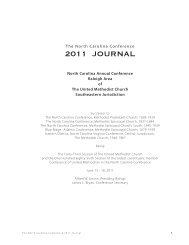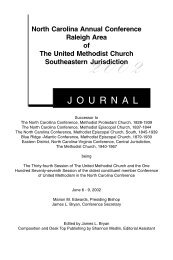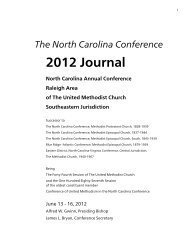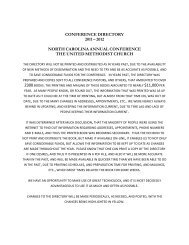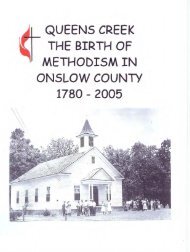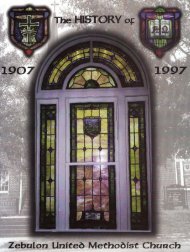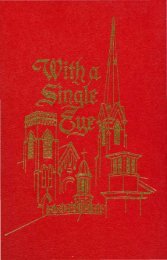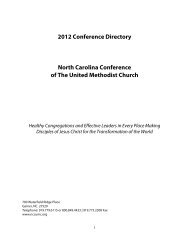Facing Tomorrow, Understanding Yesterday, A History of Orange ...
Facing Tomorrow, Understanding Yesterday, A History of Orange ...
Facing Tomorrow, Understanding Yesterday, A History of Orange ...
You also want an ePaper? Increase the reach of your titles
YUMPU automatically turns print PDFs into web optimized ePapers that Google loves.
While wedding decorations and attire in the 1930s may have been<br />
differentfrom those <strong>of</strong> the 1990s, other things took on an increasingly<br />
familiarair. About 1933, for instance, the Woman's Missionary Society<br />
dividedinto two circles, the Mary Burch and the Fannie Brockwell, which<br />
laterbecame the Catherine Ford Circle after Ford's death. Mrs. Ford lived<br />
withthe Hutchins family and contributed much to the life <strong>of</strong> the church<br />
andthe mission <strong>of</strong> the circle even though she remained an Episcopalian.<br />
Thecircles began projects <strong>of</strong>their own but continued to meet jointly; they<br />
workedtogether on other special projects and missions as they do today.<br />
The Church Cemetery<br />
The church continued to grow both in membership and in land. On<br />
February25, 1932, for example, J,E. Clark and Esther Hopkins Clark<br />
deeded.88 acres <strong>of</strong> land to the <strong>Orange</strong> Church trustees to enlarge the<br />
cemetery.The church had had a cemetery for a long time. In fact,<br />
AlexanderGattis, Ir., the first man who went out from the congregation<br />
intothe ministry, was the first to be buried in it in 1859.Records about the<br />
cemetery,like those about the church in general, are <strong>of</strong>ten more in<br />
individualmemories rather than on paper. Preston Hogan, who assumed<br />
responsibilityfor the cemetery from Lonnie Hogan in 1958, for example,<br />
recallshearing that the <strong>Orange</strong> Church plot was the final resting place for<br />
someuniversity students who died during the 1918 influenza epidemic.<br />
Theseyoung people apparently rest in unmarked graves. Early memories<br />
alsotell <strong>of</strong> mowing the lawn with a sickle mower drawn by two horses.<br />
Latera power sickle mower was used. A church committee takes care <strong>of</strong><br />
mowingand cleaning up the cemetery.<br />
More contemporaneously, in 1950,church <strong>of</strong>ficials had the cemetery<br />
leveledand the tombstones lined up. In the 1970s, a flag pole was placed<br />
inthecemetery. It was given by Wayne Hutchins in honor and in memory<br />
<strong>of</strong><strong>Orange</strong>Church veterans. The flag was donated by Wayne Noblitt. Until<br />
1955, the cemetery was a free burying ground. Then in 1956-57,a $1,600<br />
fundwasset aside for perpetual care <strong>of</strong>the grounds. Thereafter, fees were<br />
chargedfor burial. At that time, the tolls were set at $25 for a member and<br />
$50 fora non-member, which is now $75. Interest on the fund was used to<br />
payfor mowing the cemetery grounds at one time; however, this is no<br />
longertrue. In 1991, the Cemetery Committee again cleared and leveled<br />
thegrave stones.<br />
Music continued to be important in the life <strong>of</strong> the church. Annie<br />
HoganCollier played the piano during the years 1935-37.Annie played for<br />
the1936Homecoming when J.H. McCracken, who served the church as<br />
pastorfrom December 1897 to December 1901, delivered the sermon.<br />
MalcolmBlackwood directed the choir. The special anthem was the<br />
hymn"Awakening Chorus."<br />
FACING TOMORROW, UNDERSTANDING YESTERDAY 29



